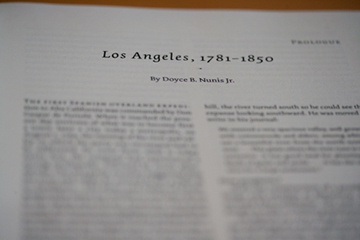
Page from Doyce Nunis's prologue in The Development of Los Angeles City Government. Photo by Sean Girard.
Brilliant historian, prolific author, and long-time editor Doyce B. Nunis Jr. died last weekend. While at the Clark Company, I worked with Dr. Nunis on Southern California Quarterly, which he edited for over forty years, until he turned over the reins to Merry Ovnick, who had been his book reviews editor. Over the course of about three years, I did hours’ worth of his corrections to his authors’ manuscripts. This was invaluable for me: seeing what an experienced editor did and—did not do—taught me volumes.
His editing wisdom saved my bacon on the second-longest book I’ve ever worked on: The Development of Los Angeles City Government: An Institutional History, 1850–2000. One thousand and thirty-eight pages long, this two-volume history had twenty-four chapters and seven appendices. Dr. Nunis was on the project’s board of editors and also wrote the prologue.
With nineteen authors coming from very different fields of study—and, therefore, documentation formats—all of the footnotes did not follow my beloved Chicago Manual of Style. I did not even know where to begin in formatting the thousands of notes consistently throughout the book. Finally, in despair, I called Bob Clark, who said only, “Call Doyce.” Doyce told me to do nothing–it was not necessary to make each chapter match the next; all that was important was that each chapter be consistent within itself so that the reader would be able to find the source being cited.
Wow! So simple! And practical! He did not even hesitate; work on over hundreds of issues of SCQ and his many books made him the voice of editorial reason. He knew what was necessary—and feasible on a short schedule—and did not get bogged down in a general rulebook.
This is just one of several happy memories of Doyce, which include his dapper phone sign-off: Right-o.